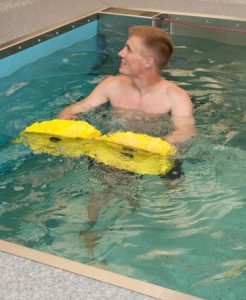Improve Athletes’ Rehab Time with Water
Once an injury has occurred, the most common question asked by an athlete is, “how long will it be until I can return to play?” Depending on the severity of the injury, it varies based on multiple factors including, the type of injury, level of injury, and health of the athlete. These factors will be reflected in the rehabilitation plan that an athletic trainer creates.

Download the ankle injury case study.
Using aquatic therapy is a rising trend because it is a great form of exercise while in the relative rest stage during rehabilitation. Adding aquatic therapy into a training room is the ideal concept for rehabilitation for athletes. Water rehabilitation therapy has been shown to cut athlete’s expected recovery time by using the general properties of water: buoyancy, resistance and weight-bearing abilities. Offering aquatic therapy in your training room allows athletes to move quickly through the rehabilitation plan. Using water is relatively pain-free and athletes are more compliant and relaxed while performing general exercises to regain muscle and stability in the injured area while in water.
By using water, it minimizes the loss of range of motion, increases blood circulation, deceases inflammation and increases the chances of the athlete advancing through rehabilitation faster compared to land-based rehabilitation. Walking in water can be undertaken without fear of injury, too.
What are the benefits of using water for rehabilitation?
- Increase in flexibility. Buoyancy offers a tremendous advantage for athletes because it reduces the effects of gravity allowing for increased range of motion.
- Increase in muscle strength. Water is more resistive than air which allows for strengthening of weakened areas around the injury.
- Decrease in pain. Immersion in warm water increases an athletes’ comfort level by promoting relaxation and removing pressure on injured areas.
The keys to instituting water rehabilitation therapy in a sports setting include: offering the best tools, hiring qualified people and implementing the best water rehab workout treatments for the athlete.
Aquatic therapy is a practical, safe solution for strength and conditioning and benefits the athletic trainers and coaches by getting the athletes back into playing shape.
Watch this unique video from the University of Virginia focusing on the rehabilitation of women’s basketball athletes back on the court after an injury and demonstrating the different phases to ensure a successful recovery:
Download the ankle injury case study here.


